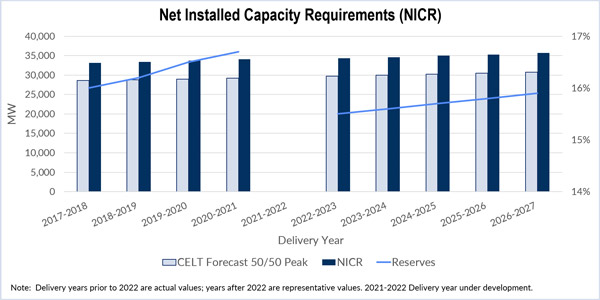MILFORD, Mass. — ISO-NE forecasts a net installed capacity requirement (ICR) value of 34,000 MW for capacity commitment period 2023/24, a 275-MW increase from the 33,725 used in February’s Forward Capacity Auction 12 for 2021/22, officials told the Planning Advisory Committee on Wednesday.
The net ICR is forecast to rise by 200-MW increments each period to 34,800 MW for 2027/28 with capacity margins dropping to 15% from 16.7% for 2021/22.
The forecast uses the same capacity and transmission transfer capability assumptions used to develop ICR values for FCA 12 but with the 2018–2027 Forecast Report of Capacity, Energy, Loads and Transmission (2018 CELT) load forecast. The FCA 12 values were based on the 2017 CELT, system planning engineer Manasa Kotha told the PAC. (See ISO-NE Capacity Prices Hit 5-Year Low.)
The RTO modeled three capacity zones for FCA 12: the Southeast New England (SENE) import-constrained capacity zone comprising Northeast Massachusetts (NEMA)/Boston, Southeast Massachusetts (SEMA) and Rhode Island; the Northern New England (NNE) export-constrained capacity zone comprising Maine, New Hampshire and Vermont; and the Rest-of-Pool capacity zone comprising Connecticut and Western/Central Massachusetts.
Comparisons of the 2018 and 2017 CELT load forecasts show that while overall New England load decreased, load in the SENE sub-areas has increased, as it did last year, Kotha said.
The increase is attributable to the Massachusetts economy continuing to grow faster relative to the other New England states, she said.
As part of its review of ICR assumptions for Operating Procedure No. 4 conditions (action during a capacity deficiency), the RTO has proposed using 700 MW of minimum operating reserves in the ICR model, an increase of 500 MW over the long-term assumption of 200 MW previously used. The new 700-MW assumption will be used in FCA 13 ICR calculations, Kotha said.
Future Locational Reserve Needs
ISO-NE foresees reserve needs in NEMA/Boston to be in the range of 250 to 700 MW for summer 2019 and 250 to 400 MW for winter 2019, Fei Zeng, technical manager for resource adequacy, told the PAC.
The RTO developed future representative operating reserve needs for the current reserve zones in NEMA/Boston, Southwest Connecticut (SWCT) and Greater Connecticut for summer and winter for study period 2018-2022. The actual requirements reported for 2018 are based on historical data of the last two years.
The forecasts did not consider the impacts of Footprint Power’s new 674-MW combined cycle power plant in Salem, Mass., “which when it goes into service by the end of the year is expected to have an impact on the following year’s calculations,” Zeng said.
Together with upgrades in the greater Boston area, the new Salem Harbor Station will help eliminate the local reserve needs for the study period, Zeng said.
In SWCT, the grid operator expects Competitive Power Ventures’ Towantic Energy Center, which began generating last month, to help reduce local reserve needs to a minimum level for summer 2019. With the assumed addition of Bridgeport Harbor 5, and the SWCT transmission upgrades, forward reserve requirements are expected to be zero for the remainder of the study period. (See related story, CPV: Subsidies — not Gas Shortages — Challenge for New Plants.)
CEII Presentations Describe Aging Infrastructure
The PAC heard five presentations on regional transmission infrastructure, which collectively described the rust in New England’s rustbelt. All five presentations were classified as containing critical energy/electric infrastructure information (CEII).
However, one stakeholder pointed out that much of what the classified material detailed would be visible to any interested commuter in the region. The needed replacements range from vintage control room equipment to brown glass insulators to replacing rusting towers.
Pradip Vijayan, ISO-NE senior engineer for transmission planning, updated the PAC on results from the SWCT 2027 needs assessment, as well as one project related to an older needs assessment for Greater Hartford/Central Connecticut.
Christopher Malone, Avangrid manager for Connecticut transmission planning, presented railroad corridor transmission line asset conditions. Maintenance of century-old catenary structures over the railroad is complicated by railroad control of 22-kV feeder/signal conductors.
Eversource Energy system planning manager Shaun Moran presented on challenges with the infrastructure in Eastern Massachusetts that carries much of the load for Cape Cod.
Kelly Csizmesia presented on behalf of National Grid’s New England Power unit, which operates transmission facilities in every regional state except Connecticut.
Transmission Projects and Asset Condition Update
Jon Breard, ISO-NE associate engineer for transmission planning, presented an update on the Regional System Plan regarding transmission projects and asset conditions, noting that seven new transmission projects totaling $146.8 million have been placed in service since the last update in March.
The RTO estimates about $1.74 billion in active reliability projects are underway now, compared to $1.9 billion in March.
Regarding asset conditions, the RTO reported one new project (the $6.3 million replacement of the Montville 16X transformer in Connecticut), and three projects placed in service since the last update in March, including: the installation of two 40-MVAR reactors on the Scobie 115-kV bus in New Hampshire ($4.7 million); replacement of the Salem Harbor Substation 115-kV oil circuit breaker ($4.6 million); and the 1231/1242 structure replacement project in Massachusetts ($8 million).
— Michael Kuser





